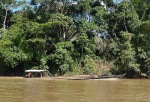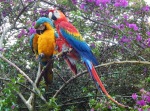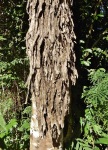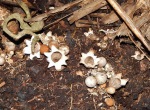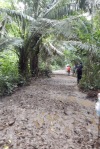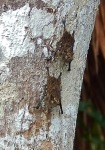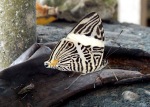My sister, Karen, and I went to Peru. A truly awe-inspiring experience. We flew into Lima and spent the night at an airport hotel. Not the greatest place to stay, but it was convenient. The hotel was nice enough, but the view from our window was of the parking lot, billboards and a six-pack of Coke that was two stories high.
An interesting side note about Coke. When Coca-Cola came to Peru it had to go head-to-head with a local drink called “Inca Cola”. Inca Cola is very popular in Peru. It’s yellow instead of brown, looks more like Mountain Dew. It has a very different flavor. And Coke couldn’t really compete. The locals didn’t find it all that tasty. So Coke did what many US companies do, they bought Inca Cola. They were smart enough not to tamper with the taste. They also then had the clout to get stores that carried Inca Cola to also carry Coca-Cola. Inca Cola still outsells Coke. At least among Peruvians….and also many tourists. As I’m not a fan of soda, pop (or soda pop, if that’s what you call it) or any carbonated drink, really. So I can’t tell you what it tastes like.
We stayed at the airport hotel because we had another flight first thing in the morning to Puerto Maldonado, Peru. This was to get us to the first part of our adventure, our “Amazonian Experience”, as the tour company dubbed it. The flight took us first to Cusco airport, then on to Puerto Maldonado. Neither airport is all that big, but Puerto Maldonado is really small. Basically about 4 gates, no jet-ways, just stairs they can roll up to the plane.
The stop in Cusco was brief. It doesn’t take long to exchange a few passengers and their luggage. But the scenery was lovely and the air was cool and crisp. Puerto Maldonado was another story. It is in the Amazon basin, in other words, jungle. Hot, humid, buggy, but also colorful, lush and full of life. The town was small with narrow streets and too much traffic for the size of those streets. But it was colorful and interesting. A small bus took us from the airport to the Madre de Dios river and the port of Puerto Maldonado. The port is little more than a couple of small floating docks where boats can tie up to load and unload.
We were headed for our lodge, Corto Maltes, on the Madre de Dios–one of many rivers that eventually flow into the Amazon. The lodge we stayed at is one of many eco-lodges along this watery jungle highway. Peru has embraced tourism as a major economic resource and everywhere we went this was in evidence. One of the more popular college degrees in Peru is a degree in tourism. That degree plus facility in one of the more popular foreign languages is a ticket from poverty to the middle class. Competition for the few spots available in the free state-sponsored colleges is fierce.
Back to the river: after boarding our boat and being handed life vests to wear (yes, they are mandated and there are river patrols that enforce the law) we headed for the lodge. There was plenty to see on the short journey up river. Small farms dot the riverbanks and boats toting everything and anything ply the waters. We saw one boat that was so loaded down with lumber being brought from the rain forest to the city that it had to have a large pump sitting atop the load to continuously pump water from the boat back into the river. The rear of the boat was so close to the water line that every wave (or large ripple!) dumped water into the boat threatening to swamp it should the pump fail.
Once we checked into our respective bungalows and got the rubber boots that would be required footwear on most of the next few days, we gathered for our first hike/educational opportunity. Our guide led us on a path into the rain forest where he identified many of the bushes and trees around us, while also detailing their uses. We saw a Brazil-nut tree and the round casing that houses the nuts in sections like an orange. We tasted a tiny root that is a local anesthetic when crushed and pressed into a wound or bad tooth. We were shown an ordinary green leaf that creates a purple dye when crushed and mixed with water. Plus sightings of many types of birds, insects and small mammals in the undergrowth.
He also warned us about putting our hands on tree trunks for balance. For instance there is an ant colony they call “devils beard” that looks like dead leaves or something on a tree trunk. It’s actually chewed leaves and mud that the ants form up on the trunk to form their housing. Not something you want to stick your hand into. Plus a lot of other things that look harmless–at first. But turn into something far different when touched. I learned to be careful very quickly. Better to land on my butt, than to touch a “24 hour” ant. So called, because the pain from the bite doesn’t begin to ease until after 24 hours has passed.
After dinner that evening (the food was excellent at every meal), we went for another boat ride. This time to view the nocturnal wildlife. It turned out to be a good night for spotting caimans. Also seen were a mama capybara and her baby and an ocelot which appeared to be very interested in the baby. It is unusual to see an ocelot in the wild, so this was a rare treat. The capybara is the worlds largest rodent. The grow to be up to 24 inches high and can weigh up to 200 pounds, although the average is around 100 pounds.
On another evening, we took a walk around the lodge grounds to spot spiders and tarantulas. There were a lot of tarantulas! We just never noticed them because they are normally nocturnal. Unless you know what you’re looking for, their nests are not obvious. But at night they all come out to hunt. And they get big in the jungle. One of the prettiest that we saw was also the most common, at least in the area where the lodge was. After dark, when you knew what to look for, they were everywhere.
After a short night’s sleep, we arose at 4:30 AM for a short boat ride to a nature preserve. Once there we embarked on a 2+ mile hike through the rain forest heading for Sandoval Lake. The actual trail to the lake is only about 1 1/2 miles, but we had to take so many detours to avoid the deepest mud on the trail (the rainy season was just ending), that it almost doubled the length of the hike.
The original time of the hike called for us to begin the trip at 10 AM. But that would have had us hiking in humid, jungle conditions during the worst heat of the day. To spare us that, our guide had us begin the trip just after dawn. Smart move. I was so soaked in sweat by the time we reached the lake that I would have qualified for a wet tee-shirt contest. And that was during the cool time of the day.
During the hike and at the lake we saw red howler monkeys, a Bufo toad (they secrete a hallucinogenic fluid when frightened or angry–don’t lick the toads!), a very large tarantula that must have lost its way, as they are nocturnal, blue and white swallows, a baby sloth, some bats roosting on a tree trunk and many other types of birds and insects.
Once we reached the lake, we got on boats and were paddled around the lake while being educated on what we were seeing. The lake itself is only temporary. It was formed when high water caused the river to change course and a bend of the river was cut off. This bend became the lake. However, since there is no source flowing into the lake to maintain its water level, it will eventually become a swamp and then finally dry out and fill in to become just another section of land.
The boat ride was interesting and the area around the lake filled with all manner of wildlife. We saw a tiger heron which only has its tiger-like stripes as a juvenile. One of the interesting features of the lake was the bright turquoise algae that grows there. At first we saw it as just clumps that drifted along on the water’s surface. But on one side of the lake it formed bands and streamers that covered the lake’s surface. The color was intense and surreal. The tiger heron was sitting above this banded surface and stretching and posing like a yoga practitioner.
Of course, after the boat ride around the lake, we had to hike that 2+ miles back to the river and the boat that would return us to our lodge. In many places the mud was up to mid-calf. Just trying to extricate the foot (while not losing the boot) was a major ordeal with each step in that thick, sticky, deep mud. But eventually we all made it back onto the boat to be returned to the lodge.
Unfortunately I missed all of the next day’s excursions as I caught something truly vile on that first full day and was unable to eat anything for the next two days. Forget walking or, for that matter, even staying awake for more than a few minutes during the first 24 hours of whatever bug it was that took temporary control of my life. But by the time we headed back down river to fly back to Lima, I was almost feeling human again.






